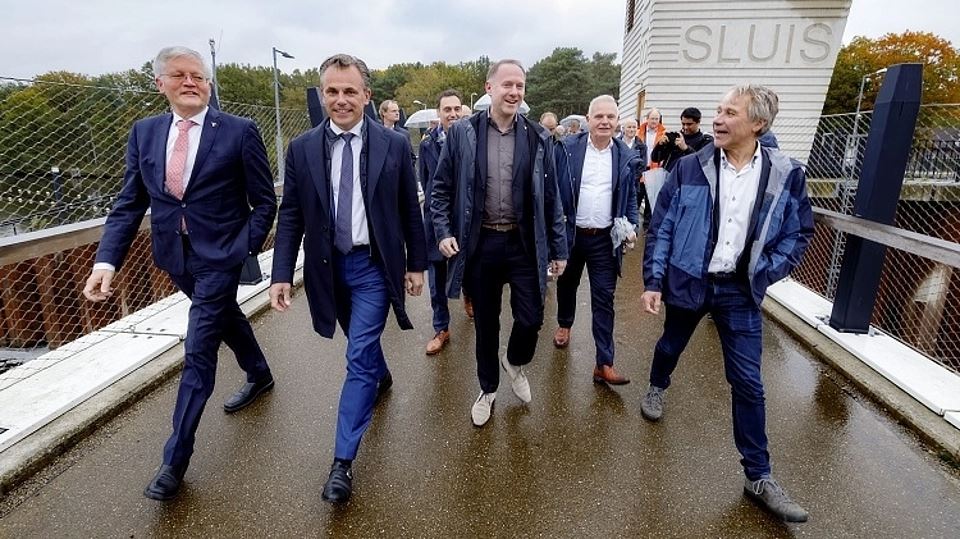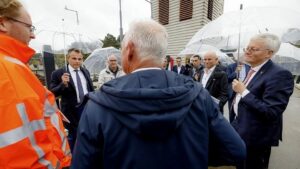Sluis III Tilburg
Forum worked on the project “Sluis III” for Tilburg in 2019, so we are proud that the news below was shared by Tilburg recently.
Credits: Gemeente Tilburg
On Monday, October 30th, Minister Harbers of Infrastructure and Water Management paid a working visit to Tilburg. The reason for the visit was the upgrading of the Wilhelmina Canal and the development of the Loven port. Together with administrators from the municipality and the province, he discussed with entrepreneurs from Tilburg who are involved or have an interest in the developments of the Wilhelmina Canal.
Minister Harbers was received by Mayor Weterings and councilors Grashoff and Van der Pol. Deputy Smeulders of the Province of North Brabant was also present.
Good access to Tilburg
Good access via water is essential for a sustainable future of Tilburg’s industrial estates. Work has been going on for a long time to improve the accessibility of the Vossenberg, Kraaiven and Loven industrial estates by water. The aim is to make the canal suitable for larger class IV ships. Councilor Rik Grashoff: “The reconstruction of Lock II is a necessary part of the Wilhelmina Canal. This ensures that our ports become more accessible for larger ships. Good to hear that Minister Harbers emphasizes the importance of water transport and that the construction of Lock II (government project) will go ahead.”
Class IV ships
Part of the program was a visit to the completely new Lock III. This lock is already suitable for ships of sailing class IV. Lock II still needs to be made suitable for the intended sailing class. Rijkswaterstaat provided an explanation on site about the work required to replace the existing lock II with a larger lock. After the reconstruction of Lock II, the canal up to and including Kraaiven is suitable for class IV ships.
Substantial investments still need to be made to make the Port of Loven accessible to larger ships. In order to increase the social added value of these investments, the discussion with the companies also discussed options for using the Wilhelmina Canal as optimally as possible. The type of company on the water-bound plots along the canal in relation to the maximum draft of ships then plays an important role. After completion of the reconstruction of Lock II, the Vossenberg and Kraaiven industrial estates will be accessible by water for class IV ships with a deep draft. Water-bound plots can be used for heavy bulk flows.
By rail and by road
The aim is to make the Port of Loven, in addition to good access by rail and road, also accessible to class IV ships, but with a limited draft. This makes this part of the canal ideally suited for larger ships with light bulk and container shipping and the Port of Loven is developing into a highly trimodal (water, road and rail) business park. “Good to see so much enthusiasm today,” said Mobility Deputy Stijn Smeulders. “Our roads are becoming increasingly congested and space on the railways is also limited. That is why water will become even more important in the coming years to keep Brabant moving. Together with the government, we must do everything we can to make freight transport over our waterways easier. ”
Furthermore, the intention of the national government and the region to further shape new tasks such as the sustainability of logistics and digitalization within the Freight Transport Corridors program in the coming years, in addition to the redevelopment of the industrial estates located along the Wilhelmina Canal, in order to further the modal shift towards inland shipping. to increase.
Minister Harbers has noted with interest the plans of the region and the desired developments for freight transport to and from Tilburg: “Tilburg has grown into a logistics hotspot in recent years. With the reconstruction of Lock II, Tilburg will become even more accessible for larger, sustainable ships. I expect that the last obstacles to the reconstruction will soon be removed and the renovation can start. This working visit shows that cooperation between entrepreneurs, the region and the government is essential to further grow water transport.”





